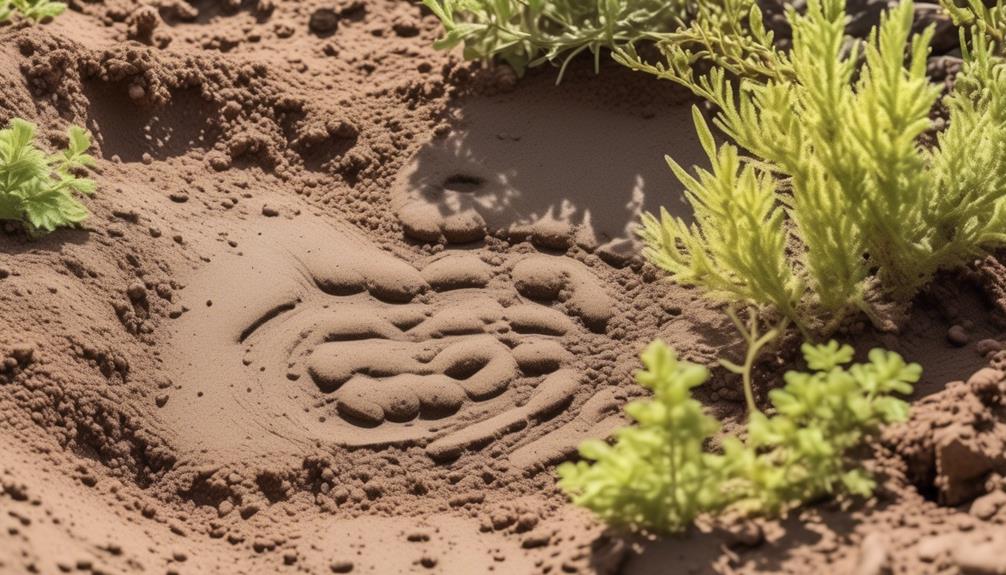Are you ready to unlock the secrets of the wild and uncover the hidden language of bobcats? Get ready to embark on a fascinating journey of discovery as we unravel the mysteries concealed within their prints and scat.
By mastering the art of reading bobcat tracks, you will be able to distinguish their unique characteristics from other animals, gaining insights into their behavior and movements.
But that’s not all! We will also delve into the intricate world of bobcat scat, unveiling the stories it tells about their diet, territorial markings, and hunting strategies.
So, prepare yourself for an adventure like no other, as we explore the fascinating realm of bobcat prints and scat.
Identifying Bobcat Prints
Identifying bobcat prints is a crucial skill for wildlife enthusiasts, researchers, and hunters alike, as it allows for accurate tracking and understanding of these elusive feline predators. When examining bobcat prints, one important characteristic to note is the absence of claw marks, unlike canine tracks.
Bobcat prints are wider than they’re tall, and a distinctive C shape can be observed in the negative space between the toe and heel pads. Additionally, bobcats have two lobes on the front of the heel pad and three on the rear.
Comparing bobcat prints to house cat prints, bobcat prints are generally larger and lack visible claw marks. The shape and proportion of the prints can also help distinguish between the two, as house cat prints are usually more symmetrical compared to the wider and asymmetrical bobcat prints.
Interpreting Bobcat Walking Gaits and Patterns
To further deepen your understanding of bobcats, let’s now explore the fascinating realm of interpreting their walking gaits and patterns.
The walking gait is the most relaxed and common gait for bobcats. In this gait, only one foot is off the ground at a time. The bobcat’s legs move forward in an alternating, diagonal pattern. It’s interesting to note that the rear paw of a bobcat is slightly smaller than the front paw. Bobcats tend to walk when they’re calm, well-fed, or in the presence of other group members.
There are different walking patterns that bobcats exhibit, depending on their purpose and the terrain they’re navigating. The first is the understep walk, where the hind paw lands behind the front foot on the same side. This indicates slow movement or stalking.
The second is the overstep walk, where the hind paw lands ahead of the front foot on the same side. This gait is used for slightly faster speeds on stable ground.
Lastly, there’s the direct register walk, where the hind paw steps into the space just occupied by the front paw on the same side. This gait ensures secure footing.
It’s important to note that these walking patterns can be influenced by the terrain and the bobcat’s familiarity with the area. Each walking pattern serves a specific purpose for the bobcat’s movement and hunting strategies.
Aging Bobcat Prints
When it comes to aging bobcat prints, weather conditions play a significant role. Tracks in mud tend to hold longer, while snow provides valuable aging information.
Impact of Weather Conditions
Weather conditions play a crucial role in the aging process of bobcat tracks, affecting their visibility and preservation.
When it comes to aging bobcat prints, snow can be a valuable tool. Fresh tracks in the snow with sharp edges and distinct features indicate recent bobcat activity, usually within 0-3 hours. As time passes, the tracks become less defined and lose their sharpness.
The presence of melted snow or ice crystals in the tracks suggests that they’re older, possibly over a day. On the other hand, mud holds tracks longer, preserving them for a more extended period.
Aging Indicators in Snow Tracks
Aging indicators in snow tracks provide valuable information about the timing and presence of bobcats in the area. When examining snow tracks, there are several key indicators that can help determine the age of the tracks:
- Sharpness: Fresh tracks will have crisp, well-defined edges, while older tracks will appear more rounded and blurred.
- Presence of snow: If the tracks are filled with fresh snow, it indicates recent activity. However, if the tracks are partially filled or covered with snow, it suggests that they’re older.
- Ice crystals: As time passes, the moisture in the tracks starts to freeze, creating ice crystals. The presence of these crystals can indicate that the tracks are older.
- Track distortion: Over time, wind and temperature changes can cause the tracks to lose their shape and become distorted. This distortion is a sign that the tracks are no longer fresh.
Bobcat Scat
Bobcat scat, resembling small dog poop, provides valuable information about the presence and behavior of these elusive predators. It can be used to identify their presence in an area and can also aid in research and tracking efforts. The average length of bobcat scat is around 4 inches with a diameter of about 1/2 inch. It’s typically brown or black in color and has blunt or tapered ends. One distinctive feature of bobcat scat is that it may contain bones and fur from smaller ungulate prey.
Bobcats have a habit of covering their dung. Before defecating, they scratch an area bare and after pooping, they kick sand or dirt over it. Male bobcats also use their urine to mark trail intersections as territorial boundaries. They scrape the ground and urinate on the spot. Bobcat scat that’s found with a urinated on scrape has a distinct odor similar to that of a house cat.
Bobcat Scat as a Territorial Marker
Bobcat scat serves as a territorial marker for male bobcats in their habitats. Here are four key ways in which bobcat scat functions as a territorial marker:
- Scent marking: Male bobcats mark trail intersections as territorial boundaries by scraping the ground and urinating on the spot. This scent marking behavior helps them establish and defend their territories.
- Covering their dung: After defecating, bobcats cover their scat with sand or dirt. This act of covering their droppings helps to conceal their presence from potential predators or competitors, while also reducing the chances of attracting unwanted attention.
- Distinct odor: Bobcat scat that has been urinated on in a scrape has a distinct odor similar to that of a house cat. This scent can be detected by other bobcats in the area, serving as a clear indication of territorial occupancy.
- Communication and recognition: By strategically placing their scat in specific locations within their territory, male bobcats communicate their presence to other bobcats. This helps them establish dominance and avoid unnecessary confrontations.
Understanding the role of bobcat scat as a territorial marker provides valuable insights into bobcat behavior and can aid in tracking and studying these elusive creatures in their natural habitats.
Benefits of Reading Bobcat Prints and Scat
Reading bobcat prints and scat provides you with the ability to track their movements, understand their behavior patterns, and ultimately enhance your hunting success.
By identifying bobcat prints, you can determine their presence in an area and gain insights into their size, gait, and habitat use.
Additionally, analyzing bobcat scat can offer valuable information about their diet, territorial marking behaviors, and reproductive habits.
This knowledge isn’t only beneficial for hunters, but also contributes to wildlife research and conservation efforts.
Tracking Bobcat Movements
Tracking the movements of bobcats can be greatly facilitated by the skill of reading their prints and scat. By observing and interpreting their tracks and droppings, you can gain valuable insights into their behavior and whereabouts. Here are four ways in which tracking bobcat movements can benefit you:
- Identify their territory: By tracking their prints and scat, you can determine the areas where bobcats roam and establish their territories. This knowledge can be useful for wildlife research and management.
- Monitor population dynamics: Tracking bobcat movements allows you to gather data on their population size and distribution. This information is crucial for conservation efforts and understanding the ecological role of bobcats in their habitats.
- Improve hunting success: For hunters, reading bobcat prints and scat can provide valuable clues about their presence and movement patterns. This knowledge can enhance hunting strategies and increase the chances of a successful hunt.
- Enhance wildlife photography opportunities: Wildlife photographers can use tracking skills to locate areas frequented by bobcats, increasing their chances of capturing stunning images of these elusive creatures in their natural habitat.
Understanding Behavior Patterns
Understanding the behavior patterns of bobcats through the skill of reading their prints and scat provides valuable insights into their ecological roles and enhances our understanding of their presence in the wild.
By analyzing their prints, we can determine their walking gaits and patterns. The walking gait, characterized by one foot off the ground at a time, is the most common and relaxed gait for bobcats. Different walking patterns, such as the understep walk, overstep walk, and direct register walk, serve specific purposes for their movement and hunting strategies.
Additionally, aging bobcat tracks can be determined by examining weather conditions and the sharpness of the tracks.
Bobcat scat, resembling small dog poop, can also provide valuable information about their behavior, such as their diet and territorial marking habits.
Understanding these behavior patterns allows us to better appreciate and protect these elusive creatures in their natural habitats.
Enhancing Hunting Success
By honing your skills in deciphering bobcat prints and scat, you can significantly increase your hunting success while gaining valuable insights into the behavior and movements of these elusive predators. Here are the benefits of reading bobcat prints and scat:
- Targeted Hunting: By understanding the size, shape, and characteristics of bobcat prints, you can identify areas where they frequent, allowing you to focus your hunting efforts in those locations.
- Tracking Abilities: Reading bobcat prints enables you to track their movements, helping you anticipate their next move and increasing your chances of a successful hunt.
- Behavioral Insights: Analyzing bobcat scat provides valuable information about their diet, preferred hunting grounds, and territorial markings, allowing you to better understand their behavior and habits.
- Research Contribution: Your skills in reading bobcat prints and scat can contribute to wildlife research, helping scientists gather data on bobcat populations, distribution, and ecological impact.
Resources for Learning About Bobcat Hunting
If you’re interested in learning about bobcat hunting, there are several valuable resources available to enhance your knowledge and skills.
One expert in the field is Dennis V. Gilmore Jr., who specializes in predator hunting. His website, ThePredatorHunter.com, offers a wealth of resources on predator hunting, including information specifically on bobcat hunting. On the website, you can find articles, videos, and tips from Gilmore himself, providing insights into various techniques and strategies for hunting bobcats.
Additionally, there are books and online forums dedicated to hunting, where experienced hunters share their knowledge and experiences. These resources can help you learn about the behavior, habits, and habitats of bobcats, as well as hunting techniques and equipment recommendations.
It’s important to note that hunting regulations and requirements vary by location, so be sure to consult your local wildlife management agency or department for specific guidelines.

Erzsebet Frey (Eli Frey) is an ecologist and online entrepreneur with a Master of Science in Ecology from the University of Belgrade. Originally from Serbia, she has lived in Sri Lanka since 2017. Eli has worked internationally in countries like Oman, Brazil, Germany, and Sri Lanka. In 2018, she expanded into SEO and blogging, completing courses from UC Davis and Edinburgh. Eli has founded multiple websites focused on biology, ecology, environmental science, sustainable and simple living, and outdoor activities. She enjoys creating nature and simple living videos on YouTube and participates in speleology, diving, and hiking.

